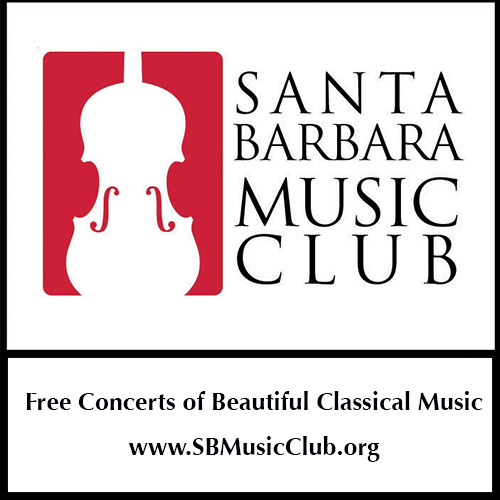
- This event has passed.
Santa Barbara Music Club Free Concerts
March 9, 2019 @ 3:00 am PST

On Saturday, March 9 at 3 p.m. the Santa Barbara Music Club will present another program in its popular series of concerts of beautiful Classical music. This afternoon, violist Rodney Wirtz and composer-pianist Paolo Tatafiore offer a program of “Retro Works.” This program features works that rely heavily on historical models for inspiration, structure, and even genre but with a bold, modernized style and sound. On today’s roster are Tatafiore’s Variations for Viola and Piano and Frédéric Chopin’s Sonata for Piano in Bb Minor, Op. 35.
This concert will be held at the Faulkner Gallery, Santa Barbara Public Library, 40 East Anapamu, Santa Barbara. Admission is free.
Violist Rodney Wirtz and composer-pianist Paolo Tatafiore perform the latter’s fresh Variations for Viola and Piano (2017). Tatafiore dedicated the work to his daughter and also attributed it to J.S.Bach, a wellspring of inspiration for countless composers. According to Tatafiore, the structure of his piece emulates that of Bach’s famous Goldberg Variations in the vein of canonic writing. Throughout the Bach’s work, he cast every third variation as a canon at successive intervals. In other words, Variation 3 is a canon at the unison; Variation 6 is a canon at the interval of a second; Variation 9 at the third, and so on. Tatafiore follows suit with 7 perfect canons at different intervals. Also as in the Goldberg Variations, Tatafiore begins and ends the piece with a statement of the main melody. In preparing to write a work that would allow for such contrapuntal flexibility, he followed the principles of his Italian mentor Giancarlo Bizzi. Bizzi studied the “Tabula mirifica omnia contrapuntisticae artis arcana revelans” (“The amazing board that reveals all the secrets of contrapuntal art”) published by A. Kircher in Rome (1650).
According to Tatafiore, Bizzi deciphered the techniques that many Renaissance and Baroque composers, including Bach, used to master the art of counterpoint. Tatafiore’s Variations betrays a deep, structural awareness of the past, and he models it after one of the most well-known sets of theme and variations in Western keyboard literature. Tatafiore departs from the historical model and retrofits it by casting it in modern harmony and melody, which includes intervals Bach typically did not employ: ninths, elevenths and sometimes thirteenths. The melody, according to Tatafiore, “is very passionate and could very well have been composed by a songwriter in the 60s or 70s of the last century.” Finally, he scored the piece for the viola because he believes “the solo possibilities of this incredible and underestimated instrument haven’t been thoroughly explored yet.”
Many fans of Frédéric Chopin (1810 – 1849) love his music because of its deep, moving lyricism. Underneath the melodic line, however, lurks a meticulously worked-out voice leading and harmonic structure. It is no wonder, then, that Chopin’s self-professed compositional inspirations are Mozart and Bach, the respective blending of lyricism and craft. Consequently, it’s not often we examine how the music of Beethoven may have informed Chopin. At the risk of sinking into generalized clichés, the Beethovenian stereotype suggests a fiery, explosive temperament, while Chopin’s stereotype suggests “the tortured poet of the piano.” Even a cursory juxtaposition of their characteristic pianism and compositional styles suggests both composers lie at opposite ends of the spectrum. Yet many scholars agree the model for Chopin’s Sonata for Piano in Bb Minor, Op. 35 (1840) is Beethoven’s Ab-major piano sonata, Op. 26. It was Chopin’s favorite – he studied, analyzed, taught, and performed it quite often. Beethoven’s Op. 26 also included a funeral march, which may have spurred Chopin to compose Op. 35. Chopin built his sonata around the now-famous funeral march, which he had composed two years prior.
In addition to the Op. 26 model, Beethoven and Chopin also share a kindred spirit in their painstaking compositional processes. Beethoven’s sketches suggest he labored – obsessed really – over a single idea. Chopin worked especially hard on composing. His work on Op. 35, according to George Sand, indicate quite a struggle. On 8 August 1839, Sand wrote how Chopin’s initial ideas for the sonata came in a flash, as if out of nowhere. Then he spent weeks at a time on a single page, rewriting it over and over, chiselling every bar. Although Beethoven ostensibly serves as a model for Op. 35 in a few ways, Chopin modernized it with his own brand of Romantic harmony, which caused very uneasy listening in its day. Its dark, unpredictable changes of color and harmony caused even Robert Schumann to critique the piece as one of annihilating horror. Luckily, posterity has been kind to the sonata, and Tatafiore returns to the keyboard this afternoon to perform the work.
The mission of the Santa Barbara Music Club is to contribute to the musical life of our community through the following actions:
●Presentation of an annual series of concerts, free to the public, featuring outstanding solo and chamber music performances by Performing Members and invited guests;
●Presentation of community outreach activities, including bringing great music to residents of area retirement homes;
●Aiding and encouraging musical education by the disbursement of scholarships to talented local music students.
For information on this or other Santa Barbara Music Club programs and performing artists, visit SBMusicClub.org.


